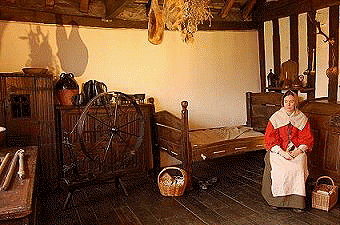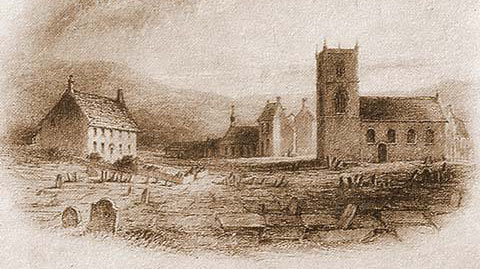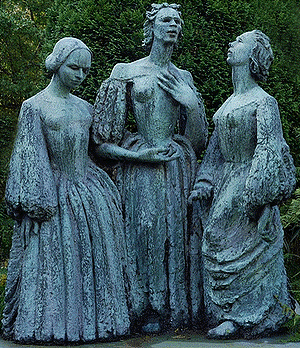About the Brontë’s
The name Brontë is one of the most famous names in English literature, the notoriety of which is shared by three sisters who’s novels have remained popular for over 150 years. Emily, Anne and Charlotte Brontë were the daughters of an Irish Anglican clergyman who settled in the small village of Haworth, West Yorkshire. All three sisters possessed exceptional levels of creativity and  imagination which they channeled into writing poetry and novels, the content of which quite often challenged the social etiquette of the Victorian time in which they lived. Of the three, Charlotte was arguably the most gifted, she certainly was the most prolific with her novel “Jane Eyre” being every bit as popular today as it was when first published. Whilst Anne Brontë’s “Agnes Grey” and “Tenant of Wildfell Hall” have received an equal level popularity in recent years, especially through television adaptation. Emily Brontë was like her sister’s, exceptionally gifted though not as productive in her works owing to prolonged illness which was ultimately to claim the lives of all the sisters. However the one novel she did finish “Wuthering Heights” is probably the most popular of all the Brontë novels and remains unique in cultivating within the popular imagination, the trials and tribulations of love and romance in the bleak wild setting of the Pennine moors.
imagination which they channeled into writing poetry and novels, the content of which quite often challenged the social etiquette of the Victorian time in which they lived. Of the three, Charlotte was arguably the most gifted, she certainly was the most prolific with her novel “Jane Eyre” being every bit as popular today as it was when first published. Whilst Anne Brontë’s “Agnes Grey” and “Tenant of Wildfell Hall” have received an equal level popularity in recent years, especially through television adaptation. Emily Brontë was like her sister’s, exceptionally gifted though not as productive in her works owing to prolonged illness which was ultimately to claim the lives of all the sisters. However the one novel she did finish “Wuthering Heights” is probably the most popular of all the Brontë novels and remains unique in cultivating within the popular imagination, the trials and tribulations of love and romance in the bleak wild setting of the Pennine moors.
About the tour
This two day tour, which can easily form part of a UK wide tour, begins in Leeds city centre and takes you on a trail to visit the most notable places that featured in the lives of these three remarkable women. Although not an academic tour our excursion will include a number of muses and readings from their books and poetry as well as notable walks they took, in an attempt to convey some of the thoughts and feelings of the Brontës concerning these places, which quite often featured as part of their work. The first day will focus in and around the village of Howarth where the Brontës spent most of their lives and include places in the surrounding area with which they also had strong associations. After an overnight stay in the area around Howarth,  our tour will take in the picturesque scenery of the Yorkshire Dales on our way to Cowan Bridge which was to have such a tragic and influential influence on the sister’s early school years, before visiting the pretty town of Kirkby Lonsdale in Cumbria for lunch. The tour will continue across the lovely rural landscape of Lancashire to the ruins of a Cistercian Abbey at Whalley in the valley of the River Ribble. After which we will visit the impressive Elizabethan house of Gawthorpe Hall near Burnley and then on through the Colne Valley before returning back to Leeds, Yorkshire over the Pennine moors via the little village of Wycoller.
our tour will take in the picturesque scenery of the Yorkshire Dales on our way to Cowan Bridge which was to have such a tragic and influential influence on the sister’s early school years, before visiting the pretty town of Kirkby Lonsdale in Cumbria for lunch. The tour will continue across the lovely rural landscape of Lancashire to the ruins of a Cistercian Abbey at Whalley in the valley of the River Ribble. After which we will visit the impressive Elizabethan house of Gawthorpe Hall near Burnley and then on through the Colne Valley before returning back to Leeds, Yorkshire over the Pennine moors via the little village of Wycoller.
A detailed description of the tour comprises the following:
Day 1
We begin our tour in central Leeds and travel by coach to visit No 74 High Street Thornton, the birthplace of all the Brontë sisters, Charlotte (1816), Emily (1818) and Anne (1820). From Thornton we travel to Birstall to see Oakwell Hall, a large stone house with Mullioned windows was “Fieldhead” in the novel “Shirley” (1849).  Oakwell Hall was built by John Batt in 1583 and is now furnished as the Batt family home in the 1690s. With a fine collection of period furniture, the Hall offers visitors a real insight into a post English Civil War. The home of Charlotte Brontë’s heroine Shirley Keelder. “The Rydings” now in commercial use, was the home of Ellen Massey the correspondent and life long friend of Charlotte, whom she had met at school and her home of Rydings with it’s distinctive crenelated roof, featured as “Thornfield Hall”. Her great friends final resting place is within the churchyard of St Peter’s Church at Birstall, which itself featured in Charlotte’s novel Shirley as Briarfield Church.
Oakwell Hall was built by John Batt in 1583 and is now furnished as the Batt family home in the 1690s. With a fine collection of period furniture, the Hall offers visitors a real insight into a post English Civil War. The home of Charlotte Brontë’s heroine Shirley Keelder. “The Rydings” now in commercial use, was the home of Ellen Massey the correspondent and life long friend of Charlotte, whom she had met at school and her home of Rydings with it’s distinctive crenelated roof, featured as “Thornfield Hall”. Her great friends final resting place is within the churchyard of St Peter’s Church at Birstall, which itself featured in Charlotte’s novel Shirley as Briarfield Church.
The tour continues to Gomersall and the Red House in Oxford Road was the home of Charlotte’s friends made at Roe Head School, Mary and Martha Taylor, who’s family appear in Shirley as the “Yorkes” and their house as “Briar Mains”. Charlotte Brontë would often stay there between 1831 and 1840 and described the house and local scenes in her novel. Oakwell Hall, Birstell was home of her heroine and Hartshead and Kirklees Park were Nummerly. Red House is today a museum with a room devoted to the Brontë’s and the novel “Shirley”. From Gomersall we travel to Law Hill Emily Brontë was a school teacher here in 1937 when the house was used as a girls school and many of her poems were written here in nostalgic mood for her home at Howarth.
and their house as “Briar Mains”. Charlotte Brontë would often stay there between 1831 and 1840 and described the house and local scenes in her novel. Oakwell Hall, Birstell was home of her heroine and Hartshead and Kirklees Park were Nummerly. Red House is today a museum with a room devoted to the Brontë’s and the novel “Shirley”. From Gomersall we travel to Law Hill Emily Brontë was a school teacher here in 1937 when the house was used as a girls school and many of her poems were written here in nostalgic mood for her home at Howarth.  At Mirfield we visit Roe Head School which was was attended by Charlotte (1831-32) who returned as a teacher for the headmistress Miss Wooler from 1835-37. Both Emily and Anne Brontë were also pupils at the school but Emily was unhappy when the school was moved to Healds House near Dewsbury by Miss Wooler and returned home after only 2 months. The building is now utilised as a school for pupils with special needs.
At Mirfield we visit Roe Head School which was was attended by Charlotte (1831-32) who returned as a teacher for the headmistress Miss Wooler from 1835-37. Both Emily and Anne Brontë were also pupils at the school but Emily was unhappy when the school was moved to Healds House near Dewsbury by Miss Wooler and returned home after only 2 months. The building is now utilised as a school for pupils with special needs.
Haworth
The Brontë Society was founded in 1855  and a museum set up over the Penny bank but was given the parsonage in 1927 and transferred there the following year, along with a collection of letters and manuscripts donated by the American philanthropist Henry Houston Bonnell. Today the house has been fully restored to resemble the Brontë home and contains a short history of the family and details the walks they took in the area, including the Brontë Waterfall, Ponden Hall and Top Withens. All of the Brontes, with the exception of Anne, are buried in the family vault marked by a commemorative plaque within the adjoining church yard of Saint Peter’s, with a stained glass window in Charlotte Brontë’s honour placed within the church itself.
and a museum set up over the Penny bank but was given the parsonage in 1927 and transferred there the following year, along with a collection of letters and manuscripts donated by the American philanthropist Henry Houston Bonnell. Today the house has been fully restored to resemble the Brontë home and contains a short history of the family and details the walks they took in the area, including the Brontë Waterfall, Ponden Hall and Top Withens. All of the Brontes, with the exception of Anne, are buried in the family vault marked by a commemorative plaque within the adjoining church yard of Saint Peter’s, with a stained glass window in Charlotte Brontë’s honour placed within the church itself.
Nestled on the eastern side of the Pennine Moors, the area around the village of Haworth changed considerably as the result of the industrial revolution in England during the 19th century At this time a rapid growth in the textile business led to a large influx of people into the area to find work and the small rural communities transformed rapidly into the large urban areas we see today.  It was during this time of great change that Patrick Brontë brought his wife and young family to the parsonage at the top of the village in 1820. Mrs Brontë died the following year and her sister took over on the care of the six children. Although not poor by the standards of the day the family were certainly not wealthy and were
It was during this time of great change that Patrick Brontë brought his wife and young family to the parsonage at the top of the village in 1820. Mrs Brontë died the following year and her sister took over on the care of the six children. Although not poor by the standards of the day the family were certainly not wealthy and were greatly afflicted by illness, with two of the children dying before reaching adolescence and the remaining four (Charlotte, Anne, Emily and their brother Branwell) dying in early adulthood. The first publication of the three sisters was a collection of poems (1846) which did not sell, under the pseudonym of “Currer, Ellis and Acton Bell”. Charlotte Brontë the wrote “The Professor” based on her studies in Brussels but this was declined by publishers for print. However Charlotte’s next book “Jane Eyre” (1847) was accepted and become
greatly afflicted by illness, with two of the children dying before reaching adolescence and the remaining four (Charlotte, Anne, Emily and their brother Branwell) dying in early adulthood. The first publication of the three sisters was a collection of poems (1846) which did not sell, under the pseudonym of “Currer, Ellis and Acton Bell”. Charlotte Brontë the wrote “The Professor” based on her studies in Brussels but this was declined by publishers for print. However Charlotte’s next book “Jane Eyre” (1847) was accepted and become  a notable success. The publication of Emily’s “Wuthering Heights” and Anne’s “Agnes Grey” also mirrored the reception of the first novel and the sister’s reputation in literary circles grew rapidly. Anne Bronte’s second novel “The Tenant of Wildfell Hall” built upon this reputation when it was published in 1848. However fate dealt a cruel blow when her sister Emily died before the success of her novel Wuthering Heights was fully realised, as the novel’s unconventional storyline did not appeal to many when first published. Anne was also struck down by illness and died barely 6 months after at Scarborough on the east coast of Yorkshire, thus ending the lives of two whose creativity had yet to be fully developed. It was
a notable success. The publication of Emily’s “Wuthering Heights” and Anne’s “Agnes Grey” also mirrored the reception of the first novel and the sister’s reputation in literary circles grew rapidly. Anne Bronte’s second novel “The Tenant of Wildfell Hall” built upon this reputation when it was published in 1848. However fate dealt a cruel blow when her sister Emily died before the success of her novel Wuthering Heights was fully realised, as the novel’s unconventional storyline did not appeal to many when first published. Anne was also struck down by illness and died barely 6 months after at Scarborough on the east coast of Yorkshire, thus ending the lives of two whose creativity had yet to be fully developed. It was left to Charlotte to continue the publication of Brontë works with her novel “Shirley” in 1849 and “Villette” in 1853 and subsequently her success led to the compilation of a biography by Mrs Gaskell at her father’s request. Charlotte’s happiness was realised by marriage to church curate Mr Nicholls after a 2 year objection by her father but the sickliness that afflicted the whole family led to a weak constitution and she tragically died in childbirth soon afterwards. Before retiring for the day to our hotel we will call at the small village of Lothersdale near Skipton. For six months Charlotte was governess for the Sidgwick family at Stonegappe Hall situated within this pretty Pennine village (which we will see externally as it is a private house) She was was not very happy there owing to the many tasks she was given “with oceans of needlework, yards of cambric to hem, muslin nightcaps to make” However in her novel “Jane Eyre” Gateshead House is where the orphaned Jane is brought up by her aunt and uncle and it is very much considered to be based on Stonegappe Hall,
left to Charlotte to continue the publication of Brontë works with her novel “Shirley” in 1849 and “Villette” in 1853 and subsequently her success led to the compilation of a biography by Mrs Gaskell at her father’s request. Charlotte’s happiness was realised by marriage to church curate Mr Nicholls after a 2 year objection by her father but the sickliness that afflicted the whole family led to a weak constitution and she tragically died in childbirth soon afterwards. Before retiring for the day to our hotel we will call at the small village of Lothersdale near Skipton. For six months Charlotte was governess for the Sidgwick family at Stonegappe Hall situated within this pretty Pennine village (which we will see externally as it is a private house) She was was not very happy there owing to the many tasks she was given “with oceans of needlework, yards of cambric to hem, muslin nightcaps to make” However in her novel “Jane Eyre” Gateshead House is where the orphaned Jane is brought up by her aunt and uncle and it is very much considered to be based on Stonegappe Hall,
Day 2
We continue our journey westwards along the A65 road to Cowan Bridge.  Situated on the north side of a bridge over the River Leck near Kirkby Lonsdale, is a row of cottages which were the Clergy Daughters School where Charlotte and Emily Bronte were pupils between 1824-25. Their elder sisters Maria and Elizabeth died of Typhus contracted here. Conditions at the school were far from being considered acceptable for young children and Charlotte described the abuses, the typhus epidemic, the scandal which followed,
Situated on the north side of a bridge over the River Leck near Kirkby Lonsdale, is a row of cottages which were the Clergy Daughters School where Charlotte and Emily Bronte were pupils between 1824-25. Their elder sisters Maria and Elizabeth died of Typhus contracted here. Conditions at the school were far from being considered acceptable for young children and Charlotte described the abuses, the typhus epidemic, the scandal which followed, and subsequent reform of the school in “Jane Eyre”. The character of Helen Burns is based closely on Maria. Reverend Brocklehurst is a portrait of William Carus Wilson, who managed the school in the Brontë’s time. When Charlotte and Emily attended the Clergy Daughters School, pupils would walk over 2 miles along a country lane to attend the parish
and subsequent reform of the school in “Jane Eyre”. The character of Helen Burns is based closely on Maria. Reverend Brocklehurst is a portrait of William Carus Wilson, who managed the school in the Brontë’s time. When Charlotte and Emily attended the Clergy Daughters School, pupils would walk over 2 miles along a country lane to attend the parish church at Tunstall where the Reverend Carus Wilson , founder of the School was the vicar. After morning service the girls were given lunch in the room above the church porch. Charlotte depicts Tunstall as “Brocklebridge” in “Jane Eyre” 1847. Charlotte described the walk across the fields to ‘Brocklebridge Church’ in her novel Jane Eyre, and you can still see the entrance to the little room above the porch where the girls ate their lunch of bread and cold meats between services. For our lunch or a cream tea, we travel 3 miles north of Tunstall to the small market town of Kirkby Lonsdale. This lively town contains many fine stone buildings and little shops. The views of
church at Tunstall where the Reverend Carus Wilson , founder of the School was the vicar. After morning service the girls were given lunch in the room above the church porch. Charlotte depicts Tunstall as “Brocklebridge” in “Jane Eyre” 1847. Charlotte described the walk across the fields to ‘Brocklebridge Church’ in her novel Jane Eyre, and you can still see the entrance to the little room above the porch where the girls ate their lunch of bread and cold meats between services. For our lunch or a cream tea, we travel 3 miles north of Tunstall to the small market town of Kirkby Lonsdale. This lively town contains many fine stone buildings and little shops. The views of  the River Lune which passes through the town were described by the writer John Ruskin as “one of the loveliest scenes in England”. It certainly was for the painter J.M.W.Turner who captured the picturesque view, which we will stop to see, in his painting of the River from behind Saint Mary’s Church in 1818. In the afternoon we travel across the beautiful Lancashire countryside to visit Whalley in the valley of the River Ribble. The ruins of Whalley Abbey occupy
the River Lune which passes through the town were described by the writer John Ruskin as “one of the loveliest scenes in England”. It certainly was for the painter J.M.W.Turner who captured the picturesque view, which we will stop to see, in his painting of the River from behind Saint Mary’s Church in 1818. In the afternoon we travel across the beautiful Lancashire countryside to visit Whalley in the valley of the River Ribble. The ruins of Whalley Abbey occupy a peaceful spot next to the River Calder and date back to the 14th century when it was a Cistercian abbey. Although there is little remaining of the original building the outer gatehouse of the abbey remains largely intact to give a general impression of it’s original appearance and this incorporated a chapel above. The Cistercian monks occupied the Abbey until dissolution of the monasteries by Henry VIII in 1537 aafter which it fell into disuse and disrepair. Charlotte Bronte was brought to view the ruins in 1850 by Sir James Kay-Shuttleworth and was taken by their pictureque quality. The adjacent medieval church has 3 Celtic Scandinavian crosses in its churchyard dating back to the 9th and 11th centuries. Our tour takes us on across the Ribble Valley to the former home
a peaceful spot next to the River Calder and date back to the 14th century when it was a Cistercian abbey. Although there is little remaining of the original building the outer gatehouse of the abbey remains largely intact to give a general impression of it’s original appearance and this incorporated a chapel above. The Cistercian monks occupied the Abbey until dissolution of the monasteries by Henry VIII in 1537 aafter which it fell into disuse and disrepair. Charlotte Bronte was brought to view the ruins in 1850 by Sir James Kay-Shuttleworth and was taken by their pictureque quality. The adjacent medieval church has 3 Celtic Scandinavian crosses in its churchyard dating back to the 9th and 11th centuries. Our tour takes us on across the Ribble Valley to the former home  of Charlotte’s host and guide Sir James at Gawthorpe Hall. The hall is a fine Elizabethan house in the town of Padiham, near Burnley in Lancashire but began as a defensive pele tower. Thispele tower was a strong square structure built in the fourteenth century as a defense against the invading Scots. The Elizabethan lodge was dovetailed around the pele tower by Lawrence Shuttleworth and incorporated modern ideas, including a main stair that is immediately accessible from the main entrance, a feature that later became standard. Work started in 1600 and was completed by 1605. The hall was owned
of Charlotte’s host and guide Sir James at Gawthorpe Hall. The hall is a fine Elizabethan house in the town of Padiham, near Burnley in Lancashire but began as a defensive pele tower. Thispele tower was a strong square structure built in the fourteenth century as a defense against the invading Scots. The Elizabethan lodge was dovetailed around the pele tower by Lawrence Shuttleworth and incorporated modern ideas, including a main stair that is immediately accessible from the main entrance, a feature that later became standard. Work started in 1600 and was completed by 1605. The hall was owned by the Kay-Shuttleworth family for over 300 years until 1970. It was redesigned in 1850 by Sir Charles Barry, who honed his skills at Gawthorpe before going on to design the Houses of Parliament. Barry’s fondness for the high Victorian Gothic Revival style being very apparent in the interior decoration, where you will find period rooms on display from the 1850 re-modeling by renowned architect Sir Charles Barry and Pugin as well as original plasterwork ceilings, panelling and the impressive Long Gallery. Also on display are over 200 pieces
by the Kay-Shuttleworth family for over 300 years until 1970. It was redesigned in 1850 by Sir Charles Barry, who honed his skills at Gawthorpe before going on to design the Houses of Parliament. Barry’s fondness for the high Victorian Gothic Revival style being very apparent in the interior decoration, where you will find period rooms on display from the 1850 re-modeling by renowned architect Sir Charles Barry and Pugin as well as original plasterwork ceilings, panelling and the impressive Long Gallery. Also on display are over 200 pieces  from the nationally important Rachel Kay-Shuttleworth textile collection. The National Portrait Gallery has loaned over 20 paintings to the Hall all of which illustrate its fascinating connections and history, particulary with the English Civil War. In 1850 Sir James Kay-Shuttleworth, owner of Gawthorpe Hall, invited Charlotte Bronte for a visit and then again in 1855. Sir James showed her the sights of his district including the ruins of Whalley Abbey near Clitheroe. After dinner at a local hotel we finish the day and our tour by a walk around the ruins of Wycoller Hall and picturesque brook nearby.
from the nationally important Rachel Kay-Shuttleworth textile collection. The National Portrait Gallery has loaned over 20 paintings to the Hall all of which illustrate its fascinating connections and history, particulary with the English Civil War. In 1850 Sir James Kay-Shuttleworth, owner of Gawthorpe Hall, invited Charlotte Bronte for a visit and then again in 1855. Sir James showed her the sights of his district including the ruins of Whalley Abbey near Clitheroe. After dinner at a local hotel we finish the day and our tour by a walk around the ruins of Wycoller Hall and picturesque brook nearby.  Built by the Hartley fanily in the 16th century it came into the ownership of Squire Henry Owen Cunliffe who died with substantial debts and the building fell into disrepair eventually being partly demolished for building stone. Despite this, much of the hall survived into the late 19th century, though it was unoccupied and steadily crumbling. The romantic quality of these ruins and it’s scenic location attracted the interest of Charlotte Bronte who based her image of “Ferndean Manor” in “Jane Eyre” on the old house. Parallels have also been drawn with the owner of Ferndean, Mr Rochester’s father, and Henry Owen Cunliffe with another of the family, Elizabeth Cunliffe, becoming Elizabeth Eyre through marriage. This possible influence on the novel also led to it’s inclusion on the cover of the 1898 edition of “Jane Eyre”.
Built by the Hartley fanily in the 16th century it came into the ownership of Squire Henry Owen Cunliffe who died with substantial debts and the building fell into disrepair eventually being partly demolished for building stone. Despite this, much of the hall survived into the late 19th century, though it was unoccupied and steadily crumbling. The romantic quality of these ruins and it’s scenic location attracted the interest of Charlotte Bronte who based her image of “Ferndean Manor” in “Jane Eyre” on the old house. Parallels have also been drawn with the owner of Ferndean, Mr Rochester’s father, and Henry Owen Cunliffe with another of the family, Elizabeth Cunliffe, becoming Elizabeth Eyre through marriage. This possible influence on the novel also led to it’s inclusion on the cover of the 1898 edition of “Jane Eyre”.
This 2 Day luxury touring holiday is only £ 274 and includes:
- 2 Full English Breakfasts.
- 2 Hot dinners either at a fine pub, hotel or restaurant.
- 1 Cream Tea in Kirkby Lonsdale
- 2 Nights accommodations at quality hotels
- Entrance fees each day to listed attractions we visit.
- Full 2 days fare on air conditioned/heated luxury coach.
- Two personal, educated tour guides filled with enthusiasm and good spirit, ready to make sure you are taken care of and have a good time!
What it doesn’t include:
- Lunch the first day
- Alcoholic beverages
- Personal spending, shopping, tipping
- Fares before and after the tour, to get you to and from home.
At Old School Tours we don’t believe in advertising what seems a ‘low price’ but doesn’t include many things we believe to be standard, such as entrance fees, dinners, breakfasts and quality hotels and B+B’s. Each day’s detail page shows the highlights of where we’ll be going and below you can find the price and what it includes. We look forward to having you on our adventure and guarantee a quality touring experience!
*Convert tour costs to your currency: XE The World’s Favorite Currency Converter Site
*Prices are at the time of publication and may vary slightly, just contact us to inquire!
*Prices are based on two people sharing (single rooms available at a supplement) For more information see: “Making a Reservation” and “Terms and Conditions”.






